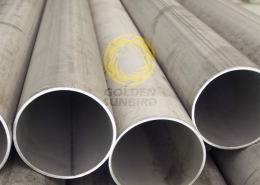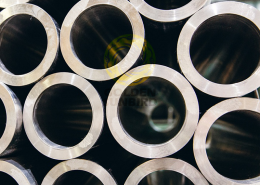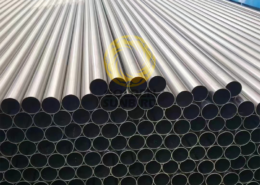ASTM B446 Inconel 625 Nickel Alloy Bar
- Grade: UNS N06625 (Inconel 625), UNS N06219, UNS N06650
- Round: 150- 300mm
- Square: 60×60-300x300mm
- Rectangular: 50-200mm x 100 x300mm
Features
ASTM B446 Inconel 625 Alloy Rod and Bar
Inconel 625 Bar Chemical Composition (wt.%)
| Element | UNS N06625 | UNS N06219 | UNS N06650 |
| Carbon | 0.10 max | 0.05 max | 0.03 max |
| Manganese | 0.50 max | 0.50 max | 0.50 max |
| Silicon | 0.50 max | 0.70-1.10 | 0.50 max |
| Phosphorus | 0.015 max | 0.020 max | 0.020 max |
| Sulfur | 0.015 max | 0.010 max | 0.010 max |
| Chromium | 20.0 – 23.0 | 18.0-22.0 | 19.0-21.0 |
| Niobium + Tantalum | 3.15 – 4.15 | – | – |
| Cobalt (if determined) | 1.0 max | – | 0.05-0.50 |
| Molybdenum | 8.0 – 10.0 | 7.0-9.0 | 9.5-12.5 |
| Iron | 5.0 max | 1.0 max | 1.0 max |
| Aluminum | 0.40 max | 2.0-4.0 | 12.0-16.0 |
| Titanium | 0.40 max | 0.50 max | 0.05-0.50 |
| Copper | – | 0.50 max | 0.30 max |
| Nickel | 58.0 min | Balance | Balance |
| Tungsten | – | – | 0.50-2.50 |
| Nitrogen | – | – | 0.05-0.20 |
Mechanical Properties For Hot-Worked Rod and Bar and Cold-Worked Rod
| Condition | Diameter or Distance Between Parallel Surfaces (in.) | Tensile Strength min (ksi) | Yield Strength (0.2% offset) min (ksi) | Elongation in 2 in. or 50 mm or 4D min (%) |
| UNS N06625 Grade 1 (Annealed) | Up to 4 incl | 120 | 60 | 30 |
| Over 4 to 10 incl | 110 | 50 | 25 | |
| UNS N06625 Grade 2 (Solution Annealed) | All sizes | 100 | 40 | 30 |
| UNS N06219 (Solution Annealed) | All sizes | 96 | 39 | 50 |
| UNS N06650 (Solution Annealed) | All sizes | 116 | 58 | 45 |
Technical Specifications
| Specification | Value |
| Standard | ASTM B446 Nickel-Chromium-Molybdenum-Niobium Alloy, Nickel-Chromium-Molybdenum-Silicon Alloy, and Nickel-Chromium-Molybdenum-Tungsten Alloy Rod and Bar |
| Grade | UNS N06625 (Inconel 625), UNS N06219, UNS N06650 |
| Manufacturing Process | Hot-worked rod and bar and Cold-worked rod |
| Delivery Condition | Grade 1 (Annealed) Material is normally employed in service temperatures up to 1100°F (593°C). Grade 2 (Solution Annealed) Material is normally employed in service temperatures above 1100°F (593°C) when resistance to creep and rupture is required. |
| Shapes | Rod, Square Bar, Rectangular Bar |
| Surface Finish | 1. Hot Finished, Annealed, or Solution-Annealed—Soft, with a tightly adherent dark oxide. 2. Hot Finished, Annealed or Solution Annealed, and Pickled. 3. Hot-Worked, Annealed, and Rough Ground. 4. Hot-Worked, Annealed, and Rough-Turned. 5. Hot-Worked, Forging Quality—Rough turned and spot ground, as necessary, for sizes 1 inch (25.4 mm) in diameter and over; rough ground and spot ground for sizes under 1 inch in diameter. 6. Cold-drawn, Annealed, or Solution-Annealed, and Pickled—Hot finished, overhauled, cold–drawn, annealed, or solution-annealed, descaled, and straightened. |
| Dimension | Round: 150- 300mm Square: 60×60-300x300mm Rectangular: 50-200mm x 100 x300mm |
| Inspection Certificate | EN 10204 Type 3.1 (Mill Test Certificate), EN 10204 Type 3.2 (Witness Testing or 3rd Party Inspection) |
| Tests | Chemical analysis ASTM E1473; Tensile Test ASTM E8; Rounding Procedure ASTM E29, UT/ET |
Packing
Small diameter packed in plywood box; large diameter packed on plywood pallets.
Application
Engine Components: These alloys’ high temperature and corrosion resistance make them ideal for turbine blades, exhaust systems, and engine thrust reversers.
Airframe Structures: Used in areas requiring high strength-to-weight ratios and excellent fatigue resistance.
Reactors and Vessels: Materials specified in ASTM B446 are used for reactors and pressure vessels that resist corrosion from aggressive chemicals.
Piping and Valves: For transporting corrosive chemicals, these alloys are used in pipes, valves, and pumps due to their superior corrosion resistance.
Offshore Oil Rigs: These include components exposed to seawater and corrosive environments, such as piping systems, valves, and heat exchangers.
Downhole Equipment: Tools and components used in drilling and exploration that require materials capable of withstanding harsh conditions and aggressive substances.
Nuclear Reactors: Used in control rod mechanisms and other reactor components because of their resistance to corrosion and radiation damage.
Gas Turbine Components: These parts, such as combustors and turbine blades, must endure high temperatures and corrosive environments.
Shipbuilding: In parts of ships and submarines, propellers and shafts are exposed to corrosive marine environments.
Desalination Plants: Components resistant to chloride and seawater corrosion, critical for desalination processes.
Pollution Control Equipment: This equipment is used in flue-gas desulfurization systems and other pollution control devices due to its ability to withstand acidic and corrosive environments.
Heat Exchangers: In industrial processing, high thermal conductivity and corrosion resistance are needed.
Food Processing Equipment: Where cleanliness and non-reactivity are critical, these materials are used due to their corrosion resistance and ease of cleaning.








